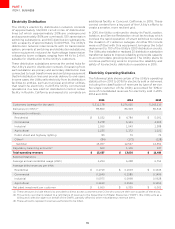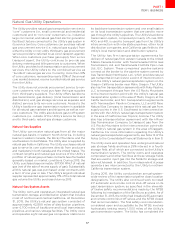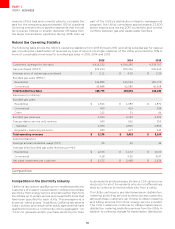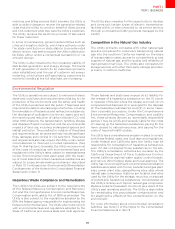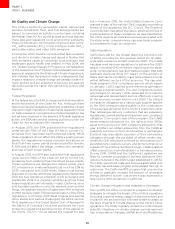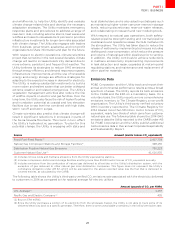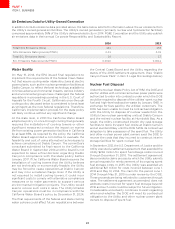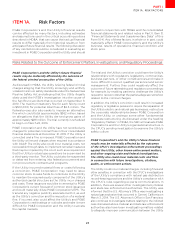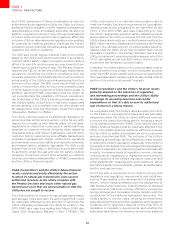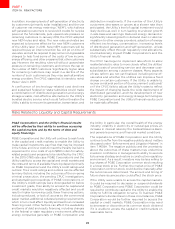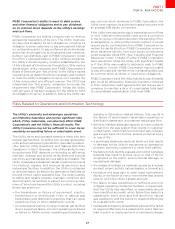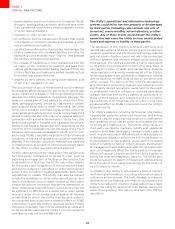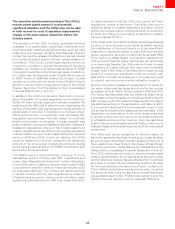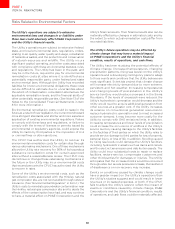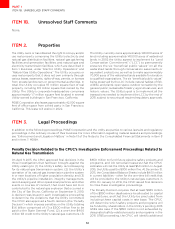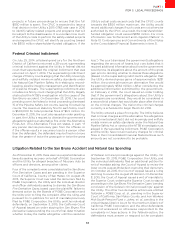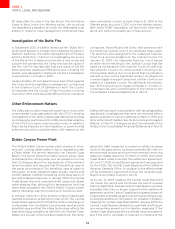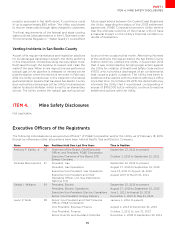PG&E 2015 Annual Report Download - page 33
Download and view the complete annual report
Please find page 33 of the 2015 PG&E annual report below. You can navigate through the pages in the report by either clicking on the pages listed below, or by using the keyword search tool below to find specific information within the annual report.
25
PART I
ITEM 1A.RISK FACTORS
to reflect changes in customer demand for the Utility’s
electricity and natural gas services.
In addition to the amount of authorized revenues, PG&E
Corporation’s and the Utility’s financial results could be
materially aected if the Utility’s actual costs to safely
and reliably serve its customers dier from authorized
or forecast costs. The Utility may incur additional
costs for many reasons including changing market
circumstances, unanticipated events (such as storms,
accidents, catastrophic or other events aecting the Utility’s
operations), or compliance with new state laws or policies.
Although the Utility may be allowed to recover some or
all of the additional costs, there may be a substantial time
lag between when the Utility incurs the costs and when
the Utility is authorized to collect revenues to recover
such costs. Alternatively, the CPUC or the FERC may
disallow costs that they determine were not reasonably
or prudently incurred by the Utility.
The Utility’s ability to recover its costs also may be aected
by the economy and its impact on the Utility’s customers.
For example, a sustained downturn or sluggishness in the
economy could reduce the Utility’s sales to industrial and
commercial customers or the level of uncollectible bills
could increase. Although the Utility generally recovers
its costs through rates, regardless of sales volume, rate
pressures increase when the costs are borne by a smaller
sales base.
Changes in commodity prices also may have an adverse
eect on the Utility’s ability to timely recover its operating
costs and earn its authorized ROE. Although the
Utility generally recovers its electricity and natural gas
procurement costs from customers as “pass-through” costs,
a significant and sustained rise in commodity prices could
create overall rate pressures that make it more dicult
for the Utility to recover its costs that are not categorized
as “pass-through” costs. To relieve some of this upward
rate pressure, the CPUC could authorize lower revenues
than the Utility requested or disallow full cost recovery.
PG&E Corporation’s and the Utility’s financial results
depend upon the Utility’s continuing ability to recover
“pass-through” costs, including electricity and natural
gas procurement costs, from customers in a timely
manner. The CPUC may disallow procurement costs
for a variety of reasons. In addition, the Utility’s ability
to recover these costs could be aected by the loss
of Utility customers and decreased new customer
growth, if the CPUC fails to adjust the Utility’s rates to
reflect suchevents.
The Utility meets customer demand for electricity from
a variety of sources, including electricity generated from
the Utility’s own generation facilities, electricity provided
by third parties under power purchase agreements, and
purchases on the wholesale electricity market. The Utility
must manage these sources using the commercial and
CPUC regulatory principles of “least cost dispatch” and
prudent administration of power purchase agreements in
compliance with its CPUC-approved long-term procurement
plan. The CPUC could disallow procurement costs incurred
by the Utility if the CPUC determines that the Utility did
not comply with these principles or if the Utility did not
comply with its procurement plan.
Further, the contractual prices for electricity under the
Utility’s current or future power purchase agreements
could become uneconomic in the future for a variety of
reasons, including developments in alternative energy
technology, increased self-generation by customers, an
increase in distributed generation, and lower customer
demand due to adverse economic conditions or the loss
of the Utility’s customers to other retail providers. In
particular, the Utility will incur additional costs to procure
renewable energy to meet the higher targets established
by California SB 350 that became eective on January 1,
2016. Despite the CPUC’s current approval of the contracts,
the CPUC could disallow contract costs in the future if it
determines that the costs are unreasonably above market.
The Utility’s ability to recover the costs it incurs in the
wholesale electricity market may be aected by the
whether the CAISO wholesale electricity market continues
to function eectively. Although market mechanisms are
designed to limit excessive prices, these market mechanisms
could fail, or the related systems and software on which
the market mechanisms rely may not perform as intended
which could result in excessive market prices. The CPUC
could prohibit the Utility from passing through the higher
costs of electricity to customers. For example, during the
2000 and 2001 energy crisis, the market mechanism flaws
in California’s then-newly established wholesale electricity
market led to dramatically high market prices for electricity
that the Utility was unable to recover through customer
rates, ultimately causing the Utility to file a petition for
reorganization under Chapter 11 of the U.S. Bankruptcy Code.
Further, PG&E Corporation’s and the Utility’s financial
results could be aected by the loss of Utility customers
and decreased new customer growth that occurs through
municipalization of the Utility’s facilities, an increase in
the number of CCAs who provide electricity to their
residents, and an increase in the number of consumers who
become direct access customers of alternative generation
providers. (See “Competition in the Electricity Industry” in
Item 1.) As the number of bundled customers (i.e., those
primarily residential customers who receive electricity and
distribution service from the Utility) declines, the rates for
remaining customers could increase as the Utility would
have a smaller customer base from which to recover certain
procurement costs. Although the Utility is permitted to
collect non-bypassable charges for generation-related costs
incurred on behalf of former customers, the charges may
not be sucient for the Utility to fully recover these costs.
In addition, the Utility’s ability to collect non-bypassable
charges has been, and may continue to be, challenged
by certain customer groups. Furthermore, if the former
customers return to receiving electricity supply from the
Utility, the Utility could incur costs to meet their electricity
needs that it may not be able to timely recover through
rates or that it may not be able to recover at all.



